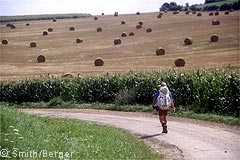This overview is the first in a series of posts about how to plan, prepare, and pack for long-distance hiking on the Appalachian Trail.
Every spring, some 2,000 people converge at Springer Mountain, the southern terminus of the Appalachian Trail’s in northwest Georgia. A couple of hundred more start later in the season, going southbound from Mt. Katahdin, the Appalachian Trail’s northern terminus in Maine.
Historically, the drop-out rate has been enormous, with some 90 percent of those who start failing to finish. More recently, according to the Appalachian Trail Conservancy, the completion rate has been higher – as much as 25 or 30 percent – perhaps due to the amount of information now available.
First Things First
Get some hiking experience! Sounds obvious? Unbelievably, some people show up at the trail having never backpacked before. Perhaps they were inspired by a slide show or a book, but it takes more than a dream to hike 2,200 miles
Long-distance backpacking involves aches and pains, smelly socks, smellier tent mates, foul weather (including mud, rain, snow, heat, and humidity), insects, rodents, roots, rocks, and sheer exhaustion. There are plenty of wonderful rewards — but not everyone is cut out to be a long-distance hiker. It’s better to find out first, before quitting a job and taking six months off!
- Preparation. Read about it. Couples, old men, young women, a blind hiker, a family: it seems that everyone has penned his or her story of an Appalachian Trail thru-hike. What’s especially interesting is that these books and Internet accounts have so much in common. Everyone, it seems, starts with a too-heavy pack.
- Fitness. It’s certainly true that the only way to truly get ready to put on a pack and walk up a mountain is to put on a pack and walk up a mountain. But hikers who are fit at the start are going to be a whole lot happier than hikers who aren’t. Anything aerobic will help.
- Equipment: One rule is constant. Packs should be as light as possible. Most experienced long-distance backpackers use the lightest gear available. Or modify gear to cut weight. You’ll find specific gear suggestions under our “Equipment” category.
- Foot preparation: Be sure shoes fit properly, are broken in and are comfortable going uphill and down — BEFORE you start your hike. Thru-hikers use either trekking shoe or hiking boots; the decision depends on pack-weight, ankle strength, and fitness.
- Resupply Planning: Most hikers pre-pack food and supplies that they have bought in advance. Then someone at home mails the boxes to general delivery at post offices along the Appalachian Trail. Zip codes can be found in the Thru-Hikers Companion or the Data Book (see the section below, on resources). It is possible to buy supplies en route, although small towns may have only a tiny convenience store with limited supplies. Most hikers send boxes to the smaller towns, and do a combination of mail drops and en-route shopping in larger towns.
Appalachian Trail Planning Resources for Itineraries and Resupply
The Appalachian Trail Conservancy has a long list of books, guides, maps, and resources on every aspect of the Appalachian Trail. Contacting them and looking through the resources available at their website and Trail Store should be your first stop.
- The A.T Data Book is a pocket-sized book containing information about trail mileages between water sources, campsites, mountain summits, road crossings, towns, and other features.
- Guidebooks and maps are available for each region of the trail from the Appalachian Trail Conservancy. Each pack contains a series of trail maps, profile maps (showing elevation change along with major landmarks), and a guidebook for that section.
- The Thru-Hiker’s Companion, published by the Appalachian Long Distance Hikers Association, contains information about major trail landmarks , but is most useful for its information about towns where hikers can resupply, do laundry, find cheap accommodations, and get meals.
Five million steps, one after the other. All it takes is thorough planning, a positive attitude, and a sense of adventure!
Karen Berger has thru-hiked the Appalachian Trail.

